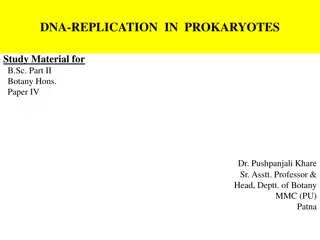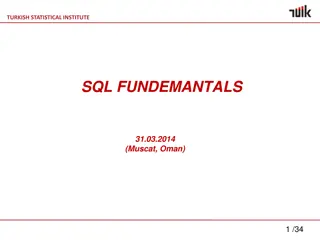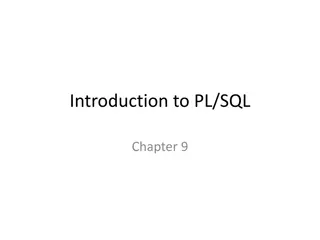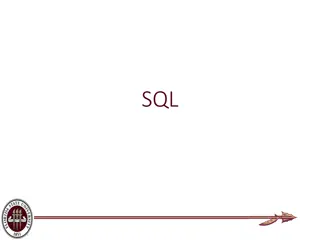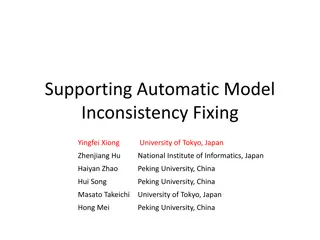Fixing SQL Server Replication Issues and Alternatives
Replication is a key technology for data distribution in SQL Server. Learn about its architecture, types, agents, and how to resolve common issues. Explore alternatives to replication and enhance your database management skills.
Download Presentation

Please find below an Image/Link to download the presentation.
The content on the website is provided AS IS for your information and personal use only. It may not be sold, licensed, or shared on other websites without obtaining consent from the author.If you encounter any issues during the download, it is possible that the publisher has removed the file from their server.
You are allowed to download the files provided on this website for personal or commercial use, subject to the condition that they are used lawfully. All files are the property of their respective owners.
The content on the website is provided AS IS for your information and personal use only. It may not be sold, licensed, or shared on other websites without obtaining consent from the author.
E N D
Presentation Transcript
Week 5, Day 3: Decorator Decorators Muddiest Point Tomorrow: Quiz on lab reading: https://faculty- web.msoe.edu/hasker/se2811/labs/5/ SE-2811 1 Slide design: Dr. Mark L. Hornick Content: Dr. Hornick Errors: Dr. Yoder
General Pattern SE-2811 2 Dr. Mark L. Hornick Wikipedia
Ex 2: Bikes SE-2811 3 Dr. Mark L. Hornick
Ex 3: Employees SE-2811 4 Dr. Mark L. Hornick http://zishanbilal.files.wordpress.com/2011/04/042811_2030_designpatte31.png
Ex 4: (Byte) Input Streams SE-2811 5 Dr. Mark L. Hornick
Knowing that the input stream classes are based on the Decorator pattern can make things easier class Input Stream Decorators io::FilterInputStream io::InputStream # in: volatile InputStream - - SKIP_BUFFER_SIZE: int = 2048 {readOnly} skipBuffer: byte ([]) # FilterInputStream(InputStream) + read() : int + read(byte[]) : int + read(byte[], int, int) : int + skip(long) : long + available() : int + close() : void + mark(int) : void + reset() : void + markSupported() : boolean + read() : int + read(byte[]) : int + read(byte[], int, int) : int + skip(long) : long + available() : int + close() : void + mark(int) : void + reset() : void + markSupported() : boolean #in io:: BufferedInputStream io::PipedInputStream io:: LineNumberInputStream io::FileInputStream <<deprecated>> io::StringBufferInputStream <<deprecated>> SE-2811 6 Dr. Mark L. Hornick
Ex 5: (Byte) Output Streams class Output Stream Decorators io::FilterOutputStream io::OutputStream # out: OutputStream + write(int) : void + write(byte[]) : void + write(byte[], int, int) : void + flush() : void + close() : void + FilterOutputStream(OutputStream) + write(int) : void + write(byte[]) : void + write(byte[], int, int) : void + flush() : void + close() : void #out io:: io:: io::DataOutputStream ObjectOutputStream PipedOutputStream io::FileOutputStream Writer io::PrintWriter Appendable io::PrintStream -psOut (with other Variables ) SE-2811 7 Dr. Mark L. Hornick
class Output Stream Decorators Ex 6: (Char) Writers + write(int) : void + write(byte[]) : void + write(byte[], int, int) : void + flush() : void + close() : void io::FilterOutputStream io::OutputStream # out: OutputStream + FilterOutputStream(OutputStream) + write(int) : void + write(byte[]) : void + write(byte[], int, int) : void + flush() : void + close() : void #out OutputStreams write (8-bit) bytes. Writers write 16-bit Unicode code-points io:: io:: io::DataOutputStream ObjectOutputStream PipedOutputStream io::FileOutputStream Writer io::PrintWriter Appendable io::PrintStream -psOut You can wrap a PrintWriter around a PrintStream You cannot wrap a PrintStream around a PrintWriter (unless you write the code yourself.) SE-2811 8 Dr. Mark L. Hornick
Implementing a new Writer decorator See example code SE-2811 9 Dr. Mark L. Hornick
In-class exercise: Modify the code to de-scramble the stream Writer writer = new ScrambleWriter(new StarInserter(new PrintWriter( System.out)))); //------- Your code here: --------- //------- End your code ---------- PrintWriter printWriter = new PrintWriter(writer,true); SE-2811 10 Dr. Mark L. Hornick
HW By Monday at 10am, email to me a Writer decorator that implements a Caesar cipher. The user should supply an integer key when creating the wrapper The CaesarWriter should add the key to the value of each character that is written to the stream. If the value goes above 255, it should wrap around through 0. Be sure to include the template write(String str, int off, int len) from ScrambleWriter We will run and debug your code in class. 11
Design Principles F Reduce coupling T Increase cohesion ? Encapsulate what varies F Favor composition over inheritance T Program to interfaces, not implementations T Classes should be open for extension but closed for modification Which of these are met? SE-2811 12 Dr. Mark L. Hornick
Downsides What are the disadvantages of decorators? SE-2811 13 Dr. Mark L. Hornick
SE-2811 14 Dr. Mark L. Hornick
Threading Muddiest Point [To be revisited in a future lecture] Lambda examples Lambda examples Lambda vs. Anon inner syntax Java 8 Quiz Lambda examples Lambda examples "Effectively Final" All lambda examples the same code? Lambda examples When would you use a Lambda expression over an anonymous class and vice versa? The Lambda is a Java thing, not an intelliJ thing right? whens the next quiz? Agree More examples of using lambdas (didn't get exposure in software dev 2) Effectively Final? SE-2811 15 Dr. Mark L. Hornick
Patterns Muddiest Point [To be revisited in a future leture] We really didn't cover any sorting algorithms and what each's benefits are Can we do an example??? Related to the quiz for below question Do we need to implement code versions of the strategy and factory method patterns?? If so how extensive and will it be similar to how we implemented in class? Implementing the methods needed for the factory method pattern. Is there a flowchart/checklist to determine which pattern is more appropriate to use? Choosing the correct design pattern What are Coupling and Cohesion and is it better to have high or low coupling or cohesion? On a quiz/test would you ask us to draw the uml of a particular general pattern, or would you just ask us to write the code? Why would we use Factory Pattern? How do you know when to use what pattern to solve a problem? Diagrams High/Low Cohesion/Coupling Class Diagram for Factory Design Pattern Nothing 16


